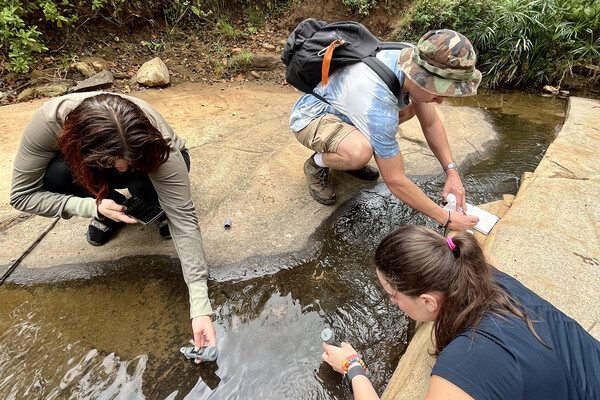
Griffin Pitt, right, works with two other student researchers to test the conductivity, total dissolved solids, salinity, and temperature of water below a sand dam in Kenya.
(Image: Courtesy of Griffin Pitt)

Trees may seem low-maintenance as far as living things go. They usually stay in one place, and the sun, rain, and soil pretty much fulfill their survival needs.
But if you’re in charge of caring for 6,800 of them, especially in an urban environment that’s also frequented by tens of thousands of students, staff, faculty, and visitors, it’s no small job.
That’s the task for staff from Penn’s Department of Facilities and Real Estate Services (FRES) and Penn’s Morris Arboretum, as well as landscape contractors. These experts assess and tend to campus trees regularly, respond to problems that may arise, and consider how to preserve and expand the tree collection at Penn, a campus which last year became an official arboretum, certified by the ArbNet Arboretum Accreditation Program.
“Over the years that I’ve been here,” says Bob Lundgren, University landscape architect, “I’ve seen a growing awareness and respect of our trees, and with the arboretum certification that’s only grown. I think we also have a more proactive mindset when it comes to caring for them, which is really great.”
Penn’s green canopy hasn’t escaped the notice of tree-lovers outside Penn as well.
“We are becoming a model for other colleges and universities to look toward to manage their tree resources,” says Jason Lubar, associate director of urban forestry at the Morris Arboretum.
So how does this team care for what is, truly, an urban forest? The primary tool is an annual assessment, led by the Morris Arboretum’s urban forestry consulting team. Lubar, a board-certified master arborist with a slew of other qualifications, and his team visit and inspect each tree on campus once a year, evaluating them primarily for safety but also noting species, height and spread, and whether they need any other attention, such as pruning or lightning protection.
“We record what actions are needed to ensure safety and prioritize them in terms of risk,” Lubar says.
That information is collected in a database and relayed to FRES and Brightview, the main landscape contractor used on campus, to ameliorate those hazards. A similar process is conducted at the Morris Arboretum.
Of course, trees can become hazardous at any time of year, and the team is responsive in case emergency tree care is needed, sometimes responding to tips from community members.
“What’s important for people to know is that we’re all around,” says Lundgren. “They can call and get someone’s attention on any problem almost immediately.”
Besides simply losing the occasional branch, certain trees can succumb to pests and diseases. Penn staff and contractors take steps to both treat those that are present, as well as ward off those that haven’t yet appeared.
Dutch elm disease, for example, a devastating fungal infection that nearly eliminated what was once one of the nation’s most abundant tree species, is a malady that the team has been managing for decades; the iconic Penn Treaty elm on College Green, as well as its descendants planted elsewhere on campus, are vulnerable. More recently, the emerald ash borer, an Asian beetle species first found in the Midwest in 2002, has made its way to the East Coast, putting the campus’s significant population of ash trees at risk.
“We coordinate to have all the ash trees treated for it every other year,” says Trish Kemper, an urban forestry technician at Morris.
And just this year, a new threat has made its way both to campus and the Arboretum, in Philadelphia’s Chestnut Hill neighborhood: the spotted lanternfly. Also native to Asia, the lanternfly targets a variety of common hardwoods, like maples and black walnuts, as well as many agriculturally significant crops, like hops and stone fruit.
“We’re waiting to see what happens and how best to treat it,” says Lubar. “We’re seeing them on campus sporadically now; next year we’ll see them more, and perhaps next year or the year after we’ll have large populations, and it could really be a problem.”
“We’re cautiously pessimistic,” says Chloe Cerwinka, Penn’s landscape planner.
One of the proposed strategies for combatting the lanternfly is culling its primary host species, the ailanthus tree, or “tree-of-heaven.”
“Attempting to eliminate the ailanthus tree in this area is quite an undertaking,” Cerwinka notes. “We can do it on campus because we don’t have that many, but, when you look at the surrounding area, they’re everywhere.”
While emerging pests can be unpredictable, one yearly maintenance task is assured. Come fall, the FRES staff must contend with the fallout from Penn’s expansive tree canopy: leaves galore.
“Each morning from 6 to 8 a.m., depending on where you are on the campus, you’re going to see a big gang clearing the leaves,” says Craig Roncace, urban park manager for FRES. “We suck up as much as we can with a giant vacuum—it looks almost like a crop duster—and use rakes and other tools to get the rest.”
The heavy machinery gets put away during the heart of the work and school day, with gardeners using hand tools to keep the landscape clean.
In line with the University’s emphasis on sustainability, the masses of collected leaves, rich with organic matter, do not go to waste. The majority stay on campus, directed to one of two mulching facilities, where they are turned over to be reapplied as mulch or compost in the University’s planting beds.
Last year Roncace, the urban park manager, asked Sam Royer, supervisor of Penn Park, to estimate how much of that mulch he put back in the campus landscape. The number? Fifty tons.
“And that was just in the month of October,” Roncace says.
Trees can live for hundreds of years, so those who care for them must take the long view. And right now that forecast looks toasty. To prepare for a changing climate, the Morris Arboretum and FRES have been joining forces to introduce tree species on campus that are adapted to warmer conditions than Philadelphia has historically experienced.
“Penn, being in a city,” says Lubar, “is already a heat island, warmer than the surrounding countryside. We’re experiencing that already, and we’re planning for it.”
With an experimental mindset, they’ve planted such species as live oaks, a variety of cherries, and Chinese ash, to see if they withstand the changing rainfall and temperature patterns and new pests we’re seeing already under climate change.
When selecting new trees to plant on the landscape, other selection criteria include increasing the overall biodiversity on campus, both of trees themselves and of the species they support. Lundgren notes that native white oaks, for example, can host dozens of types of beneficial insects and animals, so he’d be more inclined to plant one of those than a honey-locust, a beautiful but widespread species that is becoming more vulnerable to diseases.
“Some trees have more environmental value than others,” Lundgren says.
The FRES and Morris teams also work proactively to protect the trees already in place on campus. In preparation for the construction of New College House West, for example, they worked in advance of construction crews to transplant more than a dozen trees in the building zone to other sites on campus.
“It’s a nice investment we can make to ensure we’re ahead of the game, and we can see these trees continue to blossom and grow at the University,” Lubar says.
“There’s a respect for the trees on campus,” says Kemper. “When plans got underway for the new building, we heard from people who were very adamant that some of the large trees, like the London planes on Locust Walk, were not to be affected.”
Indeed, the University ensures that the Office of the University Architect, where Lundgren and Cerwinka are based, evaluates all major campus construction for its impact on significant trees, taking steps, as was done recently, to protect existing specimens. It’s a step to help ensure Penn’s urban forest sustains itself to be appreciated by the next generation.
“The bonds between the Morris Arboretum and Penn’s campus have been strengthened over the years, resulting in a much better landscape,” says Lubar. “Everybody seems to be stepping up to the plate. It’s a process sometimes, but doing it bit by bit over time we’re seeing success.”
Katherine Unger Baillie

Griffin Pitt, right, works with two other student researchers to test the conductivity, total dissolved solids, salinity, and temperature of water below a sand dam in Kenya.
(Image: Courtesy of Griffin Pitt)

Image: Andriy Onufriyenko via Getty Images

Four women street vendors sell shoes and footwear on a Delhi street.
(Image: Kannagi Khanna)

nocred